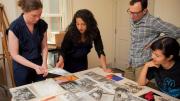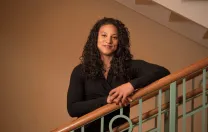When news broke in early 2018 that Radcliffe’s Schlesinger Library had acquired the papers of radical activist and academic Angela Davis, an icon since the 1970s, perhaps no one on Harvard’s campus was more thrilled than Elizabeth Hinton. “She’s one of the most important figures of the twentieth century, and her life story and political commitments intersect with pretty much every major social movement of the last 50 years—not just on a national scale, but a global scale,” explains the historian of mass incarceration, whose own work is deeply influenced by Davis’s ideas on black liberation, the “prison industrial complex” (a Davis coinage), racism in the criminal-justice system, and the consequences of incarceration for women and families.
This fall, Hinton is curating an exhibit and conference drawing on materials from those archives, which stretch from Davis’s childhood in Birmingham, Alabama, to the present and include more than 150 boxes of documents, photographs, pamphlets, letters, political buttons—and the famous FBI “Wanted” poster from the weeks in 1970 that Davis spent in hiding. It’s a collection of striking breadth, which historian Jane Kamensky, the Schlesinger’s Pforzheimer Foundation director, believes will help fill out the picture of a figure who is “known as an icon, but not as richly understood as a thinker.” Kenvi Phillips, curator for race and ethnicity, puts it another way: Angela Davis is “someone people absolutely love or absolutely hate but don’t necessarily know much about.” But “she came from somewhere, and she’s very much rooted in specific experiences and ideologies.”
The Davis papers, purchased in partnership with the Hutchins Center for African and African American Research, join kindred Schlesinger collections: those of poet-activists June Jordan and Pat Parker, composer-activist Shirley Graham Du Bois, feminist Florynce Kennedy, attorney and civil rights activist Pauli Murray (see “Two Women, Two Histories,” November-December 2007, page 29), and legal scholar Patricia Williams.
Phillips flew to Oakland, California, in late 2017 to help box up materials from Davis’s garage and bring them back to Cambridge, and Hinton and two graduate students spent months sorting and organizing. (Update August 20, 2019, 1 p.m.: Per Schlesinger Library director Jane Kamensky, the materials in the Angela Davis collection were processed by Radcliffe archivists Jenny Gotwals, Amber Moore, and Jehan Sinclair. Hinton and two graduate students, Jackie Wang and Abigail Niebuhr, began their work selecting materials for the exhibit last summer.) “It felt like such a privilege,” says Ph.D. student Jackie Wang, “I mean, in carceral studies, Angela Davis is the person. She’s one of the founding figures of the prison-abolition movement.”
“Angela Davis: Freed by the People,” opening September 20 in the Schlesinger’s newly renovated gallery, explores the racial violence of Davis’s childhood neighborhood; her philosophy studies in the Northeast, Europe, and California; and her decades of scholarship and activism as a radical feminist, civil-rights advocate, and organizer on behalf of political prisoners—and as a member of the Black Panther Party and Communist Party, and, later, co-founder of the prison-abolitionist organization Critical Resistance. And it covers her work as an author. One of Hinton’s favorite objects is a typescript of Davis’s 1974 autobiography annotated with handwritten comments from her editor, Toni Morrison, Litt.D. ’89. Another is Davis’s “Open Letter to Black High School Students,” composed in prison and set down in handwriting so perfect that it almost looks typed.
Some of the most affecting artifacts come from Davis’s early years: childhood photographs, including one as a baby with her mother, Sallye; and a card from a memorial service, sent by the family of Carol Denise McNair, one of the four young girls killed in the 1963 Birmingham church bombing. The McNairs and the Davises were friends.
Much of the exhibit centers on the turbulent period stemming from Davis’s activism for the Soledad Brothers, three incarcerated men accused of killing a white prison guard in California. In 1970, guns she had purchased were used in an attack on the Marin County Courthouse that was intended to free the Soledad Brothers but instead left four people dead, including one of the attackers. Davis was not present, but was charged with murder, kidnapping, and criminal conspiracy. After eight weeks underground (hence, the “Wanted” poster), she was captured and spent 18 months in prison, most of it in solitary confinement, before being tried and acquitted. The episode brought her international fame; “Free Angela” became a global rallying cry, and the exhibit includes numerous buttons, posters, banners, and letters of support from around the world—as well as hate mail calling her a public enemy. There are also more intimate glimpses at her ordeal: letters and cards to and from loved ones from the time of her incarceration and trial.
A related conference, “Radical Commitments: The Life and Legacy of Angela Davis,” takes place October 28-29; Davis herself is expected to attend. One focus will be the incarceration of women and its effect on families, an issue she has studied—and lived—and something “we need to know a lot more about,” explains Hinton. “It’s one of the tentacles of the carceral state.” Among those contributing to the conference will be a group of incarcerated women who have earned college degrees in prison and participated in a summer workshop that Hinton co-organized; they studied Davis’s major works and conducted research using documents from the archive. “It was really important to me—and I know important to Angela, too—to include those voices,” Hinton says. “To talk not just about these women, but with them.”









